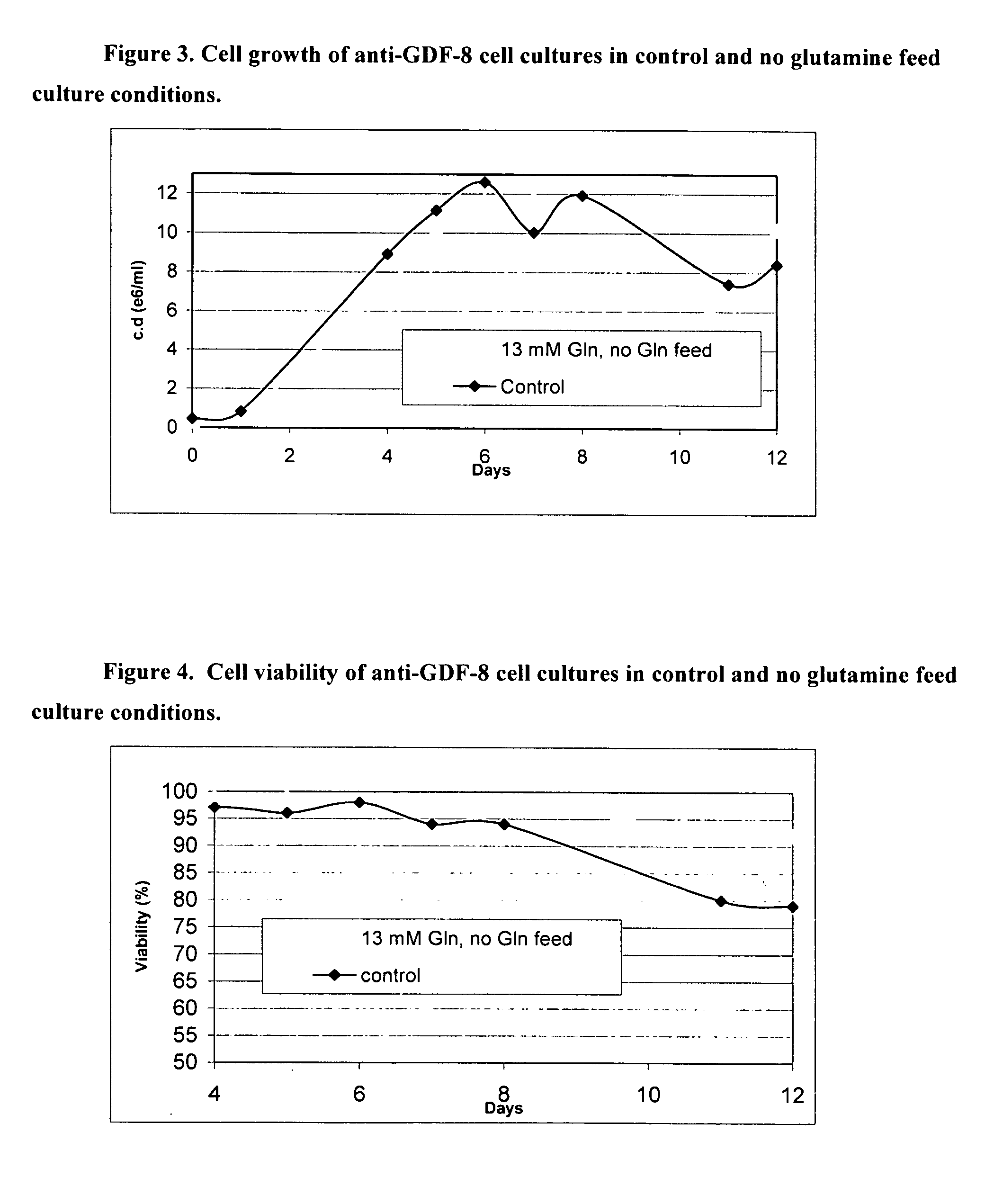Production of polypeptides
a polypeptide and polypeptide technology, applied in the field of polypeptide production, can solve the problems of metabolic waste products that have detrimental effects on cell growth, viability, production or stability, and achieve the effect of high protein production and less accumulation
- Summary
- Abstract
- Description
- Claims
- Application Information
AI Technical Summary
Problems solved by technology
Method used
Image
Examples
example 1
Enhanced Medium 1 for Anti-GDF-8 Fed-Batch Process
[0203] Traditional fed-batch processes for cultivating cell lines have several drawbacks including the time and effort required to administer the feeds and the need for special equipment in large-scale bioreactors. The objective was to develop a batch media for the production of proteins of interest in large-scale bioreactors that requires minimal feeds.
Materials and Methods
[0204] STRAINS AND MEDIA: Chinese Hamster Ovary (“CHO”) cells were engineered to express a monoclonal antibody against growth and differentiation factor 8 (“anti-GDF-8 cells”) (see Veldman et al., Neutralizing Antibodies Against GDF-8 and Uses Therefor, US20040142382 A1). Anti-GDF-8 cells were used to test a new batch media. Medium 1 and Medium 2 were compared for their abilities to support high cell density and viability. The compositions of these media, as well as Medium 3 are listed in Table 1. Media are made by adding all the components save for FeSO4.7H2O...
example 2
Development of Concentrated Feed Medium (Medium 5) for Anti-GDF-8 Cells in Fed-Batch Process
[0213] In Example 1, a batch process for culturing anti-GDF-8 cells using Medium 1 was developed. Due to the high cell density that resulted during the process, it was determined that supplementation of nutrients in addition to glucose and glutamine was still advantageous. However, supplementing the batch with 8× Medium 4 feed media would result in excessive dilution of the culture. A more concentrated feed media was developed in order to circumvent this problem.
Materials and Methods and Results
[0214] Table 2 lists the compositions of Medium 4A-1, Medium 4B, Trace B and Trace D used in the formulations of Tables 3-7.
TABLE 2Compositions of Medium 4A-1, Medium 4B, Trace B and Trace D used in theformulations of Tables 3-7.Medium 4A-1Medium 4BTrace Elements BTrace Elements DAmino Acidsmg / LmMmg / LmMmg / LmMmg / LmMalanine17.800.20arginine191.001.10asparagine.H2O135.000.90aspartic acid66.500.50glu...
example 3
Glutamine Starvation Fed-Batch Process for Anti-GDF-8 Cell Culture
[0225] CHO cells require glutamine in the starting media to survive. Traditionally, initial glutamine levels are high and glutamine is fed daily after day 5 until the end of the fed-batch process. Traditional fed-batch processes normally result in high lactate and ammonium levels in the cell cultures, which are known to have inhibitory effects on cell growth, cell density and recombinant protein expression. Fed-batch processes in which glucose is slowly added to the culture have been shown to lower lactate production and improve cell growth, cell density and recombinant protein expression. However, prior art methods for manipulation of glucose addition are not practical for large-scale manufacturing. Here, by utilizing culture media with lower starting levels of glutamine and eliminating glutamine from the feed, it is shown that lower levels of ammonium and lactate are produced, leading to increased cell viability. A...
PUM
| Property | Measurement | Unit |
|---|---|---|
| temperature | aaaaa | aaaaa |
| temperature | aaaaa | aaaaa |
| temperature | aaaaa | aaaaa |
Abstract
Description
Claims
Application Information
 Login to View More
Login to View More - R&D
- Intellectual Property
- Life Sciences
- Materials
- Tech Scout
- Unparalleled Data Quality
- Higher Quality Content
- 60% Fewer Hallucinations
Browse by: Latest US Patents, China's latest patents, Technical Efficacy Thesaurus, Application Domain, Technology Topic, Popular Technical Reports.
© 2025 PatSnap. All rights reserved.Legal|Privacy policy|Modern Slavery Act Transparency Statement|Sitemap|About US| Contact US: help@patsnap.com



